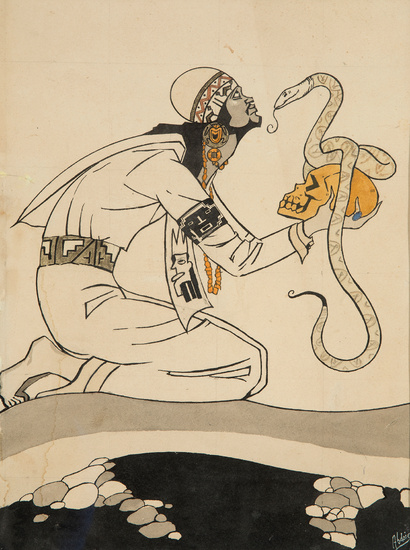European school; c. 1920.
European school; c. 1920.
"Sorcerer."
Ink and watercolor on paper.
Signed in the lower right corner.
Measurements: 32 x 23 cm; 49 x 40 cm (frame).
The orientalism was born in the 19th century as a consequence of the romantic spirit of escape in time and space. The first orientalists sought to reflect the lost, the unattainable, in a dramatic journey destined from the beginning to failure. Like Flaubert in "Salambo", painters painted detailed portraits of the Orient and imagined pasts, recreated to the millimeter but ultimately unknown and idealized. During the second half of the 19th century, however, many of the painters who traveled to the Middle East in search of this invented reality discovered a different and new country, which stood out with its peculiarities above the clichés and prejudices of Europeans. Thus, this new orientalist school leaves behind the beautiful odalisques, the harems and the slave markets to paint nothing but what they see, the real Orient in all its daily dimension. Along with the change of vision comes a technical and formal change; since it is no longer a question of recreating an imagined world in all its details, the brushstroke acquires impressionistic fluency, and the artists focus not so much on the depiction of the types and customs as on the faithful reflection of the atmosphere of the place, of the very identity of the North African populations.
HELP
Bid on this lot
European school; c. 1920.
"Sorcerer."
Ink and watercolor on paper.
Signed in the lower right corner.
Measurements: 32 x 23 cm; 49 x 40 cm (frame).
The orientalism was born in the 19th century as a consequence of the romantic spirit of escape in time and space. The first orientalists sought to reflect the lost, the unattainable, in a dramatic journey destined from the beginning to failure. Like Flaubert in "Salambo", painters painted detailed portraits of the Orient and imagined pasts, recreated to the millimeter but ultimately unknown and idealized. During the second half of the 19th century, however, many of the painters who traveled to the Middle East in search of this invented reality discovered a different and new country, which stood out with its peculiarities above the clichés and prejudices of Europeans. Thus, this new orientalist school leaves behind the beautiful odalisques, the harems and the slave markets to paint nothing but what they see, the real Orient in all its daily dimension. Along with the change of vision comes a technical and formal change; since it is no longer a question of recreating an imagined world in all its details, the brushstroke acquires impressionistic fluency, and the artists focus not so much on the depiction of the types and customs as on the faithful reflection of the atmosphere of the place, of the very identity of the North African populations.
HELP



